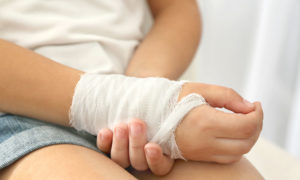When you are working and your child is left in the care of a school or childcare center, it is not uncommon to worry about the safety of your child. Each year in the United States more than 200,000 children go to the emergency room with injuries associated with playground equipment. The Consumer Product Safety Commission (CPSC) Handbook has many helpful guidelines as to the safety of such playground equipment.
This handbook is located on the CPSC website by clicking here. Many states have adopted all or parts of these standards including Arkansas, California, Connecticut, Florida, Illinois, Michigan, New Jersey, North Carolina, Oklahoma, Oregon, Rhode Island, Tennessee, Texas, Utah, Virginia and Wyoming.  Our Alabama child injury attorneys can help advise you of the policies and procedures in our state.
Our Alabama child injury attorneys can help advise you of the policies and procedures in our state.
Some of the requirements of all public playgrounds are as follows:
- The surface around playground equipment should be soft enough to ensure the least sever injury possible if falling from playground objects. It is important that the surface or ground around equipment have a depth of at least 12 inches thick of wood chips, mulch, sand, or pea gravel, or rubber like material.
- The protective surface should extend at least 6 feet in all directions from play equipment, in case the children fall off of them.
- Play structures more than 30 inches high are spaced at least 9 feet apart.
- Check for dangerous hardware.
- Spaces that could trap children usually measure less than. 3.5 inches or more than 9 inches so these spaces should be wider than this (spaces such as guard rails and ladder rungs).
- Check for sharp points or edges in equipment like open “S” hooks or protruding bolts.
- Look out for hazards that can cause tripping in extremely young children such as tree roots.
- Make sure that children play on age appropriate equipment. Some children might be too young to play on equipment that is high off the ground, since such a fall for an extremely young child could be much more severe than for some older or taller children.
- Make sure equipment and surfacing are in good condition frequently by ensuring that the playgrounds are maintained properly.
- Careful supervision is a must. Depending on just how young the children are, they should be supervised accordingly.
Soft Surfaces
Because most playground injuries (almost 80%) are caused from falls to the ground, improper surfacing is the first thing to look at on a playground in determining the safety of them for your children. Regular maintenance of the ground is important and the ground must not be too hard so that if a fall were to occur, it would be less likely to result in serious injury. Concrete grounds can be dangerous if there are objects that a child could fall from above a certain height, meaning that the impact from the fall onto concrete would likely result in sever injury. A depth of 12 inches of material that can cushion a fall such as wood chips, bark mulch, sand, and pea gravel is recommended by the national safety standards for a fall zone of 6 feet. A fall zone is just how high up objects that a child could get on top of are, which means they could fall from there.
If supervising children on the playground, common sense should be used as well. If a piece of equipment is 10 feet off the ground with no guard rails, then an extremely young child should not be playing on top of it since such a fall would likely result in a devastating injury. Much of supervision (by educators, day care specialists, or even parents or relatives) is determining the risks involved and balancing the need for safety with the ability for the child to play freely.
If your child has been a victim of an accident on a playground it is important that the institution follows a public safety checklist or you may be able to seek legal action by contacting a child injury attorney. For more information on the regulations and safety standards of playgrounds for children you can go to the Consumer Product Safety Commission’s website.
Attorney Steven A. Harris regularly blogs in the areas of family law, bankruptcy, and real estate closings on this website. He is always available in any of the firm’s offices or by phone anytime for a consultation. Mr. Harris tries to provide informative information to the public in easily digestible formats. Hopefully you enjoyed this article and feel free to supply any feedback. We appreciate our readers and love to hear from you!



